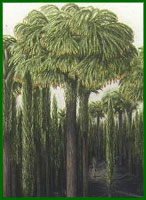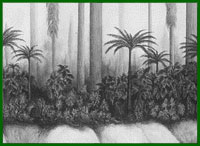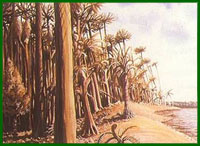 |
|
|||
|
Coal Coal is the remains of peat that has been compressed so that almost all that is left is carbon. For enough peat to accumulate so that it can generate significant deposits of coal, two main conditions are required. Firstly, large quantities of plant material have to be produced, which usually involves fast growing pants living in dense stands. Secondly, the rate of decay of the plant tissue after death has to be minimal. These conditions can be met in a variety of habitats but tropical swamp forests are particularly productive peat producers.
These giant club-mosses were not seed plants as are most large plants growing today; they reproduced by producing spores. They nevertheless looked superficially very like trees, growing to heights of up to 40 metres. Unlike a true tree, however, the trunk contained relatively small amounts of wood. Instead, much of the trunk consisted of soft tissue called periderm, which enabled the plants to grow much quicker than woody trees. Most of these club-mosses grew in a way normally found today in many smaller, herbaceous plants: they grew into mature plants, reproduced, and then died. Most modern-day trees, in contrast, reproduce for many years after reaching maturity. For this reason, many palaeontologists call these extinct plants giant herbs rather than trees. There are club-mosses still alive today, but they are now all small, herbaceous plants, no more than a few centimetres high. Their common name reflects how they look superficially like true mosses (the 'club' refers to the shape of the spore bearing cones that most produce). However, they were one of the most important groups of large plants growing in the Coal Forests.
There were lakes and ponds within the swamps where no plants grew except algae. Around the margins of these lakes grew thickets of tree-like plants called calamites, reaching heights of ten metres or more. Their modern-day relatives are the horsetails, which still grow abundantly today throughout most of the world. Again, like the club-mosses they are much smaller. As with a modern tropical rain forest, tree-sized plants dominated the vegetation. Smaller plants have problems competing for light with the giants of the forest, and have to adapt other strategies to survive. In today's tropical forests, many non-tree plants are lianas, which can grow up the trunks of the trees to reach the light, or epiphytes that are adapted to growing in the crowns of the trees. We have evidence of both lianas and epiphytes in the Coal Forests, although they were not as abundantly or as diverse as in the modern forests.
The geological evidence of the Coal Forests is found today in the coalfields, of which we have two in Wales. The North Wales Coalfield lies in the north-east of the country and is in effect a westerly extension of the Lancashire Coalfield. The South Wales Coalfield is very much larger extending westwards from near the border with England to the far coast of Pembrokeshire. Between these two coalfields is an area known as the Wales-Brabant Massif, which was a rather drier area during the Late Carboniferous where the Coal Forests could not develop.
Interest in the Coal Measures used to be mainly because they represent such an important fuel resource. Understanding the geology of these deposits helped miners to dig for coal in more economic ways. Recently, however, geologists are taking a fresh look at these deposits. Although they were formed so many millions of years ago, they represent a time that has many features in common today. It was the only other time in the geological past when there was both extensive polar ice and large-scale tropical forestation. Understanding the events that took place in the Carboniferous can, therefore, provide us with valuable insights into the effects that are causing climate change today. top |
||||

 During
the Carboniferous Period, 300 million years ago, Wales lay very near the
equator. Most land was then merged into a single supercontinent known
as Pangea. Wales lay in a large area of wetlands that extended from what
are now the Appalachians, across the Canadian Maritimes and northern Europe,
to Poland (known and the Variscan Foreland). They represented an ideal
habitat for a group of large plants known as the giant club-mosses that
were highly adapted to growing in low nutrient, waterlogged soils. No
other plants could survive in these hostile conditions. They were extremely
fast growing plants; it has been estimated that their 1-2 m wide stems
could grow upwards at several metres per year. After they died, the acidic
waterlogged substrate helped to slow down the decay of the plants. Conditions
were, therefore, almost ideal for the production of thick peat deposits
that we now see preserved as the thick coal deposits of the Welsh coalfields.
The forests are often referred to as the Coal Forests.
During
the Carboniferous Period, 300 million years ago, Wales lay very near the
equator. Most land was then merged into a single supercontinent known
as Pangea. Wales lay in a large area of wetlands that extended from what
are now the Appalachians, across the Canadian Maritimes and northern Europe,
to Poland (known and the Variscan Foreland). They represented an ideal
habitat for a group of large plants known as the giant club-mosses that
were highly adapted to growing in low nutrient, waterlogged soils. No
other plants could survive in these hostile conditions. They were extremely
fast growing plants; it has been estimated that their 1-2 m wide stems
could grow upwards at several metres per year. After they died, the acidic
waterlogged substrate helped to slow down the decay of the plants. Conditions
were, therefore, almost ideal for the production of thick peat deposits
that we now see preserved as the thick coal deposits of the Welsh coalfields.
The forests are often referred to as the Coal Forests.  Other
plants also grew in the Coal Forests, but mainly in the less waterlogged
areas, such as on the raised banks of rivers that threaded their way through
the swamps. Here were tree ferns, looking very similar to those tree ferns
growing today in places like New Zealand (although belonging to different
families of fern to the modern ones). There were also some seed plants
belonging to a number of now extinct groups such as the cordaites (distant
relatives of today's conifers) and the medullosales or seed-ferns (distant
relatives of the cycads).
Other
plants also grew in the Coal Forests, but mainly in the less waterlogged
areas, such as on the raised banks of rivers that threaded their way through
the swamps. Here were tree ferns, looking very similar to those tree ferns
growing today in places like New Zealand (although belonging to different
families of fern to the modern ones). There were also some seed plants
belonging to a number of now extinct groups such as the cordaites (distant
relatives of today's conifers) and the medullosales or seed-ferns (distant
relatives of the cycads).  The
only abundant herbaceous ground plants in the Coal Forests are the sphenophylls.
These were scrambling plants that were probably capable of rapid growth
to cover open areas within the forest when they became available, perhaps
by a tree fall. The sphenophylls are somewhat of a mystery-group of plants.
They had leaves arranged in circles around the stem, similar to those
of horsetails, and it has generally been thought that they were distantly
related to that group. However, the reproductive cones and the leaves
are quite different, so it seems that they represent a totally extinct
group of plants with no closer relatives alive today.
The
only abundant herbaceous ground plants in the Coal Forests are the sphenophylls.
These were scrambling plants that were probably capable of rapid growth
to cover open areas within the forest when they became available, perhaps
by a tree fall. The sphenophylls are somewhat of a mystery-group of plants.
They had leaves arranged in circles around the stem, similar to those
of horsetails, and it has generally been thought that they were distantly
related to that group. However, the reproductive cones and the leaves
are quite different, so it seems that they represent a totally extinct
group of plants with no closer relatives alive today.  The
geological evidence for the Coal Forests in Wales is preserved in rocks
known as the Coal Measures. These consist of intervals of mainly grey
shale and sandstone, separated by much thinner beds of coal. The shale
and sandstone represent the sediment that had accumulated in the rivers
and lakes in the swamps, while the coals are the compressed beds of peat.
The weight of the sediment has caused the peat to become considerably
compressed; current estimates are that the coals such as found in Wales
represent only a sixth of their original thickness when they were peat.
Despite appearances to the contrary, a typical Coal Measures sequence
should therefore be seen as representing vast thicknesses of peat separated
by relatively thin intervals of sediment.
The
geological evidence for the Coal Forests in Wales is preserved in rocks
known as the Coal Measures. These consist of intervals of mainly grey
shale and sandstone, separated by much thinner beds of coal. The shale
and sandstone represent the sediment that had accumulated in the rivers
and lakes in the swamps, while the coals are the compressed beds of peat.
The weight of the sediment has caused the peat to become considerably
compressed; current estimates are that the coals such as found in Wales
represent only a sixth of their original thickness when they were peat.
Despite appearances to the contrary, a typical Coal Measures sequence
should therefore be seen as representing vast thicknesses of peat separated
by relatively thin intervals of sediment.